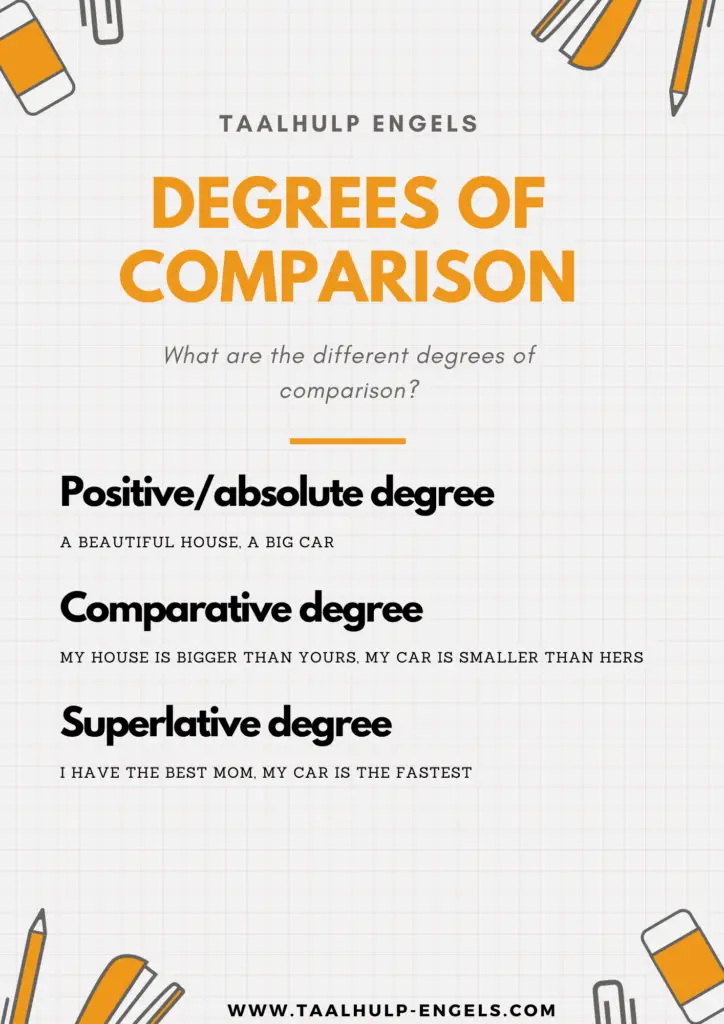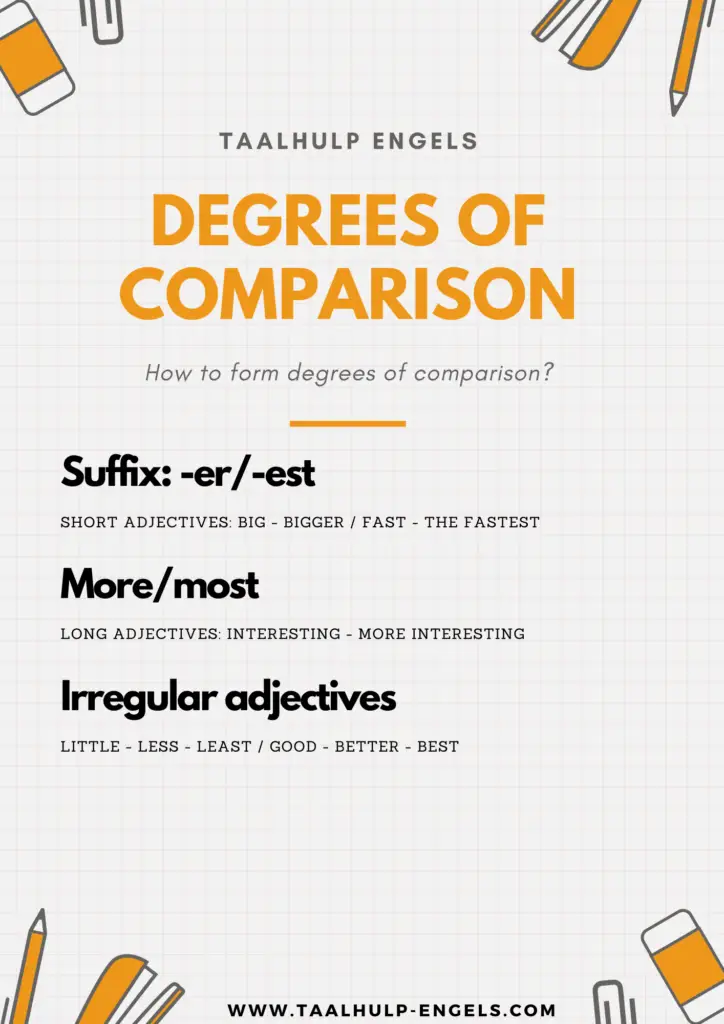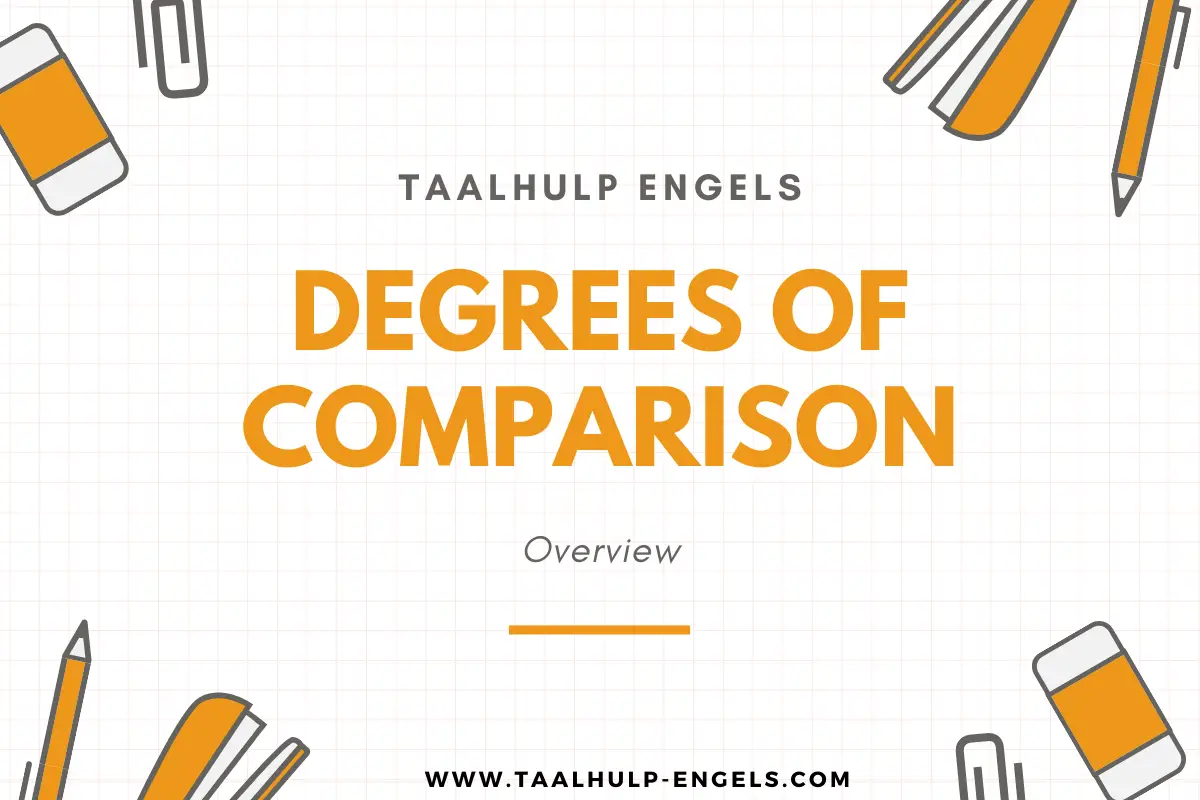Adjectives are mostly used to describe things or people, but can also be used to compare things or people. If you want to compare people or things, you need to use the degrees of comparison. On this page, you have a full overview of what this is exactly, how you form them and there are also several examples.
Degrees of comparison
You can compare things or people by using adjectives, but it’s important that you know what you want to say. Are you comparing several things to one another? Or do you want to say that one is the best, the biggest, the smallest, …?

Positive/absolute degree
This is the first degree of comparison but isn’t really used to compare things. This is the standard form of the adjective to describe how a noun is. For example:
| a beautiful house |
| a big car |

Comparative degree
Comparing two items, things, or people is done by using the comparative degree of comparison. You would say that one is bigger or smaller than the other, for example.
Use:
‘… than …’
Take a look at the following examples:
| My car is bigger than her car. |
| His house is smaller than mine. |
| I am faster than my brother. |
| My sister is smarter than me. |
Superlative degree
The superlative degree of comparison is when you want to say something or someone has a certain characteristic in the highest degree. You don’t compare two or more things or people to each other, but you compare the thing you are talking about to all other examples of that thing.
You would say:
‘the …’
Take a look at the following examples:
| I have the best mom. |
| My sister is the smartest person I know. |
| My car is the fastest. |
| I am the strongest person on earth. |
| My house is the biggest. |
In these examples, you see that you’re not really comparing two things to each other, but you are saying that a thing, person, or animal has a certain characteristic to the highest degree. In the final sentence, you don’t compare two houses, but your house is the biggest house of all houses that exist.
Degrees of comparison form
The different degrees of comparison can be formed in two different ways. The first way is by adding a suffix to the base adjective and the second possibility is by putting an extra word before the adjective.
Suffix (-er / -est)
In order to express the degrees of comparison, you need to add a suffix to some adjectives. For the comparative degree, you need to add <er> to the base adjective. For the superlative degree, you need to add <est> to the base adjective.
When you are dealing with a short adjective (1 syllable or 2 syllables when it ends in -er, -le, -ow or -y), you need to add <er> for the comparative degree and <est> for the superlative degree.
| bigger than |
| the fastest |
| happier than |
| hotter than |
| the cleverest |

If you want to express the superlative degree of an adjective that ends in -y, the <y> usually changes into <ie>.
When you have a short adjective that ends in a consonant and this consonant comes right after a short vowel, this consonant is doubled.
| a big book |
| your book is bigger than my book |
| the book is the biggest |
More / most
When you are dealing with a long adjective (other adjectives of two or more syllables), you put an extra word in front of the adjective to express different degrees of comparison. ‘More’ is used for the comparative degree and ‘most’ for the superlative degree. Take a look at the examples below:
| more interesting than |
| more hopeful than |
| the most fertile |
| more amazing than |
| the most difficult |
Irregular adjectives
The degrees of comparison of some adjectives cannot be formed by adding a suffix or adding more or most. These adjectives are irregular. Take a look at the list below to see the most common irregular adjectives.
| Adjective | Comparative degree | Superlative degree |
|---|---|---|
| little | less | least |
| old | older/elder | oldest/eldest |
| good | better | best |
| far | farther/further | farthest/furthest |
| many (telbaar) | more | most |
| much (ontelbaar) | more | most |
| bad | worse | worst |


Exercises
- Degrees of Comparison Exercise 1
- Degrees of Comparison Exercise 2
- Degrees of Comparison Exercise 3
- Degrees of Comparison Exercise 4
- Degrees of Comparison Exercise 5


